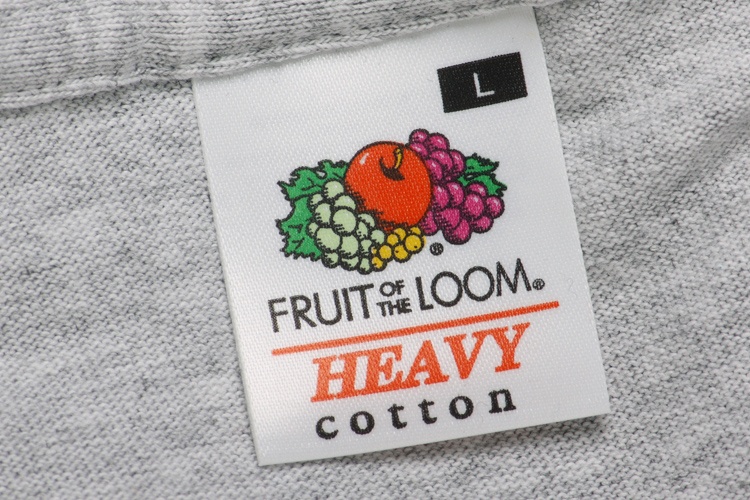Fruit of the Loom is has been around for over 200 years, and it owns one of the oldest trademarks in US history. The company is the top seller of men’s underwear in the US and one of the most recognized names in the world.

A Fruitful Enterprise
In 1851, brothers Benjamin and Robert Knight bought a mill in Warwick, Rhode Island. Under the name B.B. and R. Knight Corporation, they began making high-quality cotton cloth to sell to textile manufacturers.
In 1870, the brothers registered the name Fruit of the Loom for their company. It was trademark number 418, and it is one of the oldest trademarks in the country.
An Inspiring Visit
The name was inspired by a visit to one of the mill’s customers, a cloth manufacturer named Rufus Skeel. While he was at the Skeel factory, Robert discovered that Skeel’s daughter Jessica painted fruits on some of the bolts of cloth. Skeel said the decorated bolts sold more quickly than the others.
Ever since, Fruit of the Loom has used apples and other fruit in its trademark. A loom is an old-fashioned machine that was used to make thread and cloth. In choosing this name, the Wrights were referring to cloth as the “fruit” or product of the loom.
The First Logo
In 1893, the company released its first logo. It was an elegant logo in the style many companies used. It showed a red apple, green grapes, currants and purple grapes.
The logo was a rectangular frame surrounding a beautiful painting of the fruits set against a colorful sky. The company name appeared in an arching label above the fruit. In 1927, the logo took on an oval shape but kept the fruit painting.
In 1936, the company began using a logo that looked more like a seal, and the fruits seemed to disappear. The logo went through minor changes over the next decades until its major overhaul in 1978.
An Underwear Innovator
In 1928, Fruit of the Loom began licensing its name to makers of finished clothing products. One of them was a clothing manufacturer named Joseph Goldfarb, who began selling Fruit of the Loom products for the Union Underwear Company.
Goldfarb insisted he could become profitable by offering high-quality underwear at a low price, and he was right. By 1930, Goldfarb owned a factory in Kentucky that employed 650 people.
Goldfarb was a true underwear innovator. In the 1940s, he pioneered the idea of selling boxer shorts in sets of three. Today, this packaging is the industry standard for men’s underwear. In the 1950s, he became the first underwear maker to advertise on television.
By the 1960s, Fruit of the Loom was the most popular maker of men’s underwear. The company later expanded into casual wear and women’s underwear.
The Fruit of the Loom Guys
In 1975, the company launched the well-known Fruit of the Loom Guys in its advertising. They wore fruit costumes and raved about the comfort of Fruit of the Loom products. The “guys” turned Fruit of the Loom into the most recognized underwear brand in the country.
The Logo in the 1970s
In 1978, the logo went through another big change.
In that year, the fruits appeared above an oval seal with a black border, a white background and the words “Fruit of the Loom” in black lettering. This was a crisp, striking look that made the company name the center of attention. This remained the basic logo until recent years.
Today, the logo shows the fruits in a simple, stamped design floating over the company name with no frame and no border. The fruits are in bold, primary colors.
The Mandela Effect
The Fruit of the Loom logo has another distinction. It’s a prime example of what social scientists call “the Mandela effect.” This is the phenomenon of large numbers of people who insist they remember something that never happened.
Writer Fiona Broome coined the term in 2009. She was at a conference with a group of people who remembered hearing about Nelson Mandela’s death in a South African prison in the 1980s. These people shared detailed memories of the funeral and his widow’s speech.
When she got home from the conference, however, she discovered Mandela was very much alive. He died in 2013. Broome began researching other instances of this phenomenon and discovered it was more common than anyone might have guessed.
There Is No Horn
The Fruit of the Loom logo frequently gets cited as an example of this effect. Many people insist the logo has a cornucopia, and others swear they’ve seen earlier versions of the logo with one. Some websites still post pictures of the logo with the “horn of plenty,” insisting that it’s the correct one.
If they looked at their tee shirt label, however, they’d see the truth. In reality, the Fruit of the Loom logo has never had a cornucopia.
Fruit of the Tomb
In 2017, Fruit of the Loom sued a Texas company named En Garde for selling a line of underwear and tee shirts it called Fruit of the Tomb. It’s a clever name for clothing that has Gothic and Halloween-related themes, but Fruit of the Loom thought the name infringed on its trademark. Fruit of the Loom sued En Garde, but a court dismissed the motion.
Avoid potential legal issues – read how to trademark your logo.
Fruits Are Here To Stay
Fruit of the Loom has been a textile maker and an underwear innovator. Today, it is a global company that employs more than 25,000 people worldwide. Its fruity logo is a well-known symbol of comfort.

